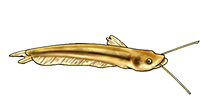Help for my pygmy corys
Help for my pygmy corys
I have 5 pygmy corys in a 20 gallon tank with 6 white clouds and 6 neons. When I first got them they were extremely active, zooming all around the tank. They have now taken to hiding in the plants at the back of the tank. I don't know if they are getting enough food now because they move about so little and remain still for most of the time. The white clouds and neons will eat the their pellets as well as the flake food. I haven't seen the other fish intimidating the pygmys at all, but could they be afraid of them anyway? My water parameters are:
ph <8
ammonia/nitrite nil
nitrate circa 60 (high levels in tap water)
These haven't changed from when I first got the pygmys.
They were fine for weeks and I cannot pinpoint what may have changed or be wrong. Can anyone offer me any suggestions, please?
ph <8
ammonia/nitrite nil
nitrate circa 60 (high levels in tap water)
These haven't changed from when I first got the pygmys.
They were fine for weeks and I cannot pinpoint what may have changed or be wrong. Can anyone offer me any suggestions, please?
- clothahump
- Posts: 441
- Joined: 30 Dec 2002, 17:24
- Location 1: Deepest Darkest Dorset UK
- Contact:
This will probably be wrong but here goes.
The only thing I can see as a slight problem are high Nitrates and the Ph is slightly high for my likings, try and rectify the Nitrates first and then address the Ph, 7.5 would be better.
Do a couple of good quality water changes and do not feed for two days, when you feed again just add a little and see if they take it.
I have Pygmaeus in a heavily planted tank that gets a small water change when I remember and they are doing fine.
More plants will use up the Nitrates and make them feel more secure.
Has the water authority added any chemicals to the supply?
Have you used anything Toxic in or near the aquarium?
Think if you have done anything different over the last few weeksm could be something simple.
The only thing I can see as a slight problem are high Nitrates and the Ph is slightly high for my likings, try and rectify the Nitrates first and then address the Ph, 7.5 would be better.
Do a couple of good quality water changes and do not feed for two days, when you feed again just add a little and see if they take it.
I have Pygmaeus in a heavily planted tank that gets a small water change when I remember and they are doing fine.
More plants will use up the Nitrates and make them feel more secure.
Has the water authority added any chemicals to the supply?
Have you used anything Toxic in or near the aquarium?
Think if you have done anything different over the last few weeksm could be something simple.
- Coryman
- Expert
- Posts: 2119
- Joined: 30 Dec 2002, 19:06
- My articles: 12
- My catfish: 5
- My cats species list: 83 (i:3, k:0)
- My BLogs: 1 (i:0, p:46)
- Spotted: 194
- Location 1: Kidderminster UK
- Location 2: Kidderminster, UK
- Interests: Cory's, Loricariids, photography and more Cory's
- Contact:
glc
Firstly where are you from? I like to know where the folks I am talking to are!
Cory's are generally a shy bunch and if you give them a lot of cover they will take advantage of it. When first introduced they will be all over the tank familiarizing themselves with their new surroundings, then they will settle where they are most comfortable.
What clothahump has said is right so I won't duplicate his coments, the only other thing that would affect C. pygmaeus is the temperature, they do not like it to warm. a range of 72 - 74 F would be about right for them.
To make sure that your C. pygmaeus are getting enough food add a little last thing at night after the lights go out. If you use flake food, take a little pinch and hold it in the water before releasing it then it will sink straight away. Cory's are just as active at night as they are in the day, maybe more so.
Ian
Firstly where are you from? I like to know where the folks I am talking to are!
Cory's are generally a shy bunch and if you give them a lot of cover they will take advantage of it. When first introduced they will be all over the tank familiarizing themselves with their new surroundings, then they will settle where they are most comfortable.
What clothahump has said is right so I won't duplicate his coments, the only other thing that would affect C. pygmaeus is the temperature, they do not like it to warm. a range of 72 - 74 F would be about right for them.
To make sure that your C. pygmaeus are getting enough food add a little last thing at night after the lights go out. If you use flake food, take a little pinch and hold it in the water before releasing it then it will sink straight away. Cory's are just as active at night as they are in the day, maybe more so.
Ian
-
Cory_lover
- Posts: 196
- Joined: 22 Feb 2003, 12:39
- My cats species list: 13 (i:0, k:0)
- My aquaria list: 5 (i:0)
- Location 1: Melbourne
- Location 2: Australia
- Interests: Corydoras fanatic
Thanks for all your help. I'm English by the way, Northamptonshire. I do keep the temperature at about 73 so that's okay. I didn't realise pygmys were particularly active at night so I will change the feeding regime for them and see if that helps. Why don't textbooks give more information? I've got eight, one for catfish alone, and none mention the night-time activity! My nitrates are high and I do try hard to keep them down. Tried hard with the pH level also. I have begun mixing tap water with filtered water (AP's Tap Water Filter) half and half and that seems to be having an effect, although not as much as I had hoped. The mix looks like it's about 7.8. I don't think there has been any addition to the water. I have lodged a request with the water authority to let me know if they flush the system with anything suspect. I use dechlorinators though as well.
I appreciate your help and will bear everything you said in mind - it's hard this fishkeeping, but I'll persevere.
I appreciate your help and will bear everything you said in mind - it's hard this fishkeeping, but I'll persevere.
- Coryman
- Expert
- Posts: 2119
- Joined: 30 Dec 2002, 19:06
- My articles: 12
- My catfish: 5
- My cats species list: 83 (i:3, k:0)
- My BLogs: 1 (i:0, p:46)
- Spotted: 194
- Location 1: Kidderminster UK
- Location 2: Kidderminster, UK
- Interests: Cory's, Loricariids, photography and more Cory's
- Contact:
If you have the facility try collecting rain water, if this is not possible and you have space for a water but, try filling it with tap water and half fill an old pillow case with moss peat and leave it to soak for a few weeks, the colour will be like weak tea but the pH should be a lot better than you have now. Another way would be to put dead Oak or Beach leaves into the tank, they float to start with but soon sink to the bottom, the efect is quite good as well.
Most if not all Catfish are to a degree nocturnal.
Ian
Most if not all Catfish are to a degree nocturnal.
Ian
- clothahump
- Posts: 441
- Joined: 30 Dec 2002, 17:24
- Location 1: Deepest Darkest Dorset UK
- Contact:
- Sid Guppy
- Posts: 757
- Joined: 31 Dec 2002, 15:36
- Location 1: Brabant, the Netherlands
- Interests: Catfish, Tanganyikan fish, Rock'n'roll, Fantasy
Corydorus, I wouldn't risk my fish, just because peat might cost, if I were you.
Tea contains some fairly strong substances, not to mention cafeine; wich is poisonous for aquatic life, even in minute quantities.
Stick to peat.
If you want to do it, just a bit, get some oak- or beechleaves, and use those. Be careful where you collect those; because insecticides, pesticides and car-exhaust-fume-residu can and will clear out the whole tank in short time!
Tea contains some fairly strong substances, not to mention cafeine; wich is poisonous for aquatic life, even in minute quantities.
Stick to peat.
If you want to do it, just a bit, get some oak- or beechleaves, and use those. Be careful where you collect those; because insecticides, pesticides and car-exhaust-fume-residu can and will clear out the whole tank in short time!
Plan B should not automatically be twice as much explosives as Plan A








